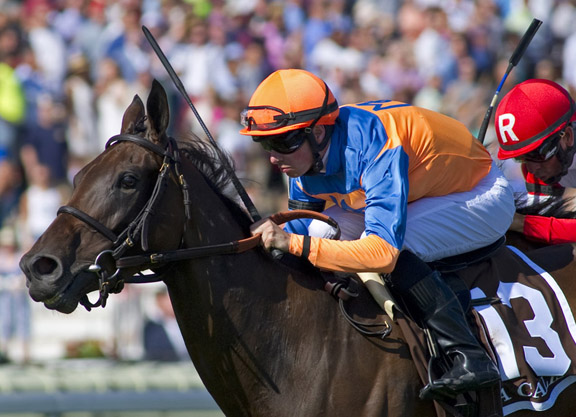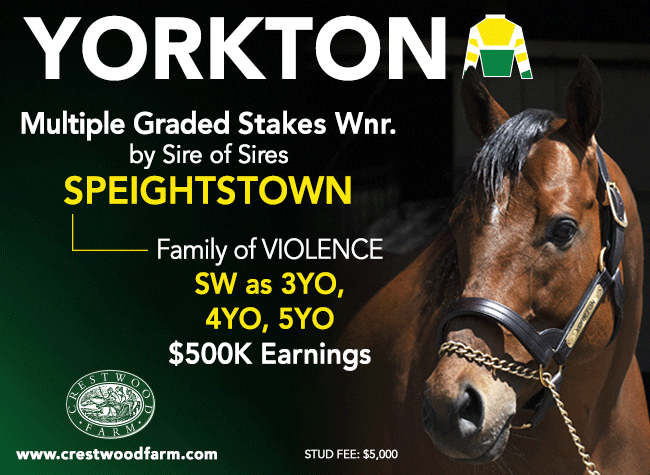With the media currently offering wall-to-wall coverage of the Olympics, I had the misfortune to hear a BBC radio debate in which a sports journalist questioned why anyone should be praised for winning a silver or bronze medal. Inevitably that saying beloved by Americans–that second place is just the first loser–reared its ugly head.
I believe that phrase is attributed to Dale Earnhardt, a famous NASCAR driver nicknamed The Intimidator, but the sentiment has spread to many other sports. Indeed, horse racing is far from blameless in this respect. All the glory tends to go to the winner, even if the winning margin is small and the runner-up has shown top-class ability. In America the fact that the second may have been giving weight to the winner is often overlooked (even the TDN doesn't include the weights to be carried in American races on the day of the race–not even for handicaps–though it does earlier in the week).
The clear message is that it is crossing the line in front that counts. This is unfortunate for that fine horse Youmzain, who qualifies as one of the biggest losers of all time under Earnhardt's criterion.
Although this son of the G1 Derby, G1 Irish Derby and G1 Arc winner Sinndar became a Group 1 winner at the first attempt in the 2006 Preis von Europa and later took the 2008 G1 Grand Prix de Saint-Cloud, he found one too good for him in seven other Group 1 events. Among these efforts were seconds in three consecutive editions of the Prix de l'Arc de Triomphe. He was beaten only a head by Dylan Thomas in the first of them and it took champions of the calibre of Zarkava and Sea The Stars to get the better of him in the others. In two of his other “first loser” efforts–the 2009 G1 Coronation Cup and the 2010 Grand Prix de Saint-Cloud–the margin of defeat was a mere nose, and he was also second in Dylan Thomas' G1 King George.
By the end of Youmzain's long and distinguished career, his owner Jaber Abdullah was richer to the tune of £3,395,844 and he had finished first, second or third in a remarkable total of 15 Group 1 races. Youmzain had also been rewarded with Timeform ratings of 125 at three (when he also beat the future G1 Breeders' Cup Turf winner Red Rocks in the G2 Great Voltigeur S.), 127 at four, 131 at five, 130 at six and 123 at seven.
In an era when soundness should be at a premium, Youmzain clearly had plenty to offer as a stallion, but he had two major prejudices to overcome–in addition to his being without a win during his last three years in training. Commercial breeders generally do not gravitate to mile-and-a-half performers and it can't have helped that his sire Sinndar had proved less effective as a stallion than he'd been on the track.
The end result was that Youmzain began his stallion career at Haras du Quesnay at a fee of only €3,000–a far cry from the €85,000 initially charged for Sea The Stars and the €50,000 asked for Dylan Thomas in his first year. This modest price proved sufficiently enticing for Youmzain to sire 66 foals in his first crop, foaled in 2012, followed by 53 in 2013 and 63 in 2014–not bad figures for a stallion based in France, where crop sizes tend to be smaller than in Ireland and Britain. France-Galop credits him with 59 foals in 2015, with the fact that there are five non-thoroughbreds among them suggesting that he is beginning to draw attention from the jumping community.
It will be fascinating to see how many mares Youmzain attracted this year, at a fee of €4,000, as breeders will surely have noticed that he was represented by stakes winners from his first two crops in 2015.
Although Youmzain was precocious enough to win in the August of his 2-year-old season, it was a little surprising to see his son Suits You win the Chesham S. at Royal Ascot (in the process earning himself a one-way ticket to Hong Kong). Less surprising was the emergence of a very smart 3-year-old middle-distance filly in the shape of Sea Calisi. After winning the G2 Prix de Malleret in her first appearance in Martin S. Schwartz's colours, Sea Calisi finished a close third in the G1 Yorkshire Oaks and third again behind the imperious Treve in the G1 Prix Vermeille.
Schwartz's decision to switch his Youmzain filly to the U.S. is now paying handsome dividends, with the 4-year-old winning at Grade II and Grade I levels. Her victory in Saturday's Beverly D. S. carried the added bonus of a “Win and You're In” ticket to the GI Breeders' Cup Filly & Mare Turf.
Of course Schwartz has an enviable record of winning the Beverly D. with European imports, having also won with Angara in 2005, Gorella in 2006 and Stacelita in 2011. It is worth mentioning that Schwartz has a habit of selling these smart racemares. Angara RNA'd at $2.2 million in 2005, but was sold to the Sangster family, while Gorella and Stacelita were sold to Japan, where Stacelita's second foal, the Frankel filly Soul Stirring, recently made a very encouraging winning start to her career.
Incidentally, is Sea Calisi another good filly named with reference to Daenerys Targaryen, of Game of Thrones? We have already seen Dothraki Queen win the GII Pocahontas S. and finish third in the GI Breeders' Cup Juvenile Fillies; Galileo's daughter Khaleesy become a listed winner in France this year; and Kitten's Joy's daughter Khaleesi was recently Group 1 placed in Brazil. There are also young fillies and mares named Khaleesi in the U.S., Ireland, France, Australia, New Zealand, South Africa, India, Argentina and Mexico, and it is a similarly widespread story with Daenerys.
To get back to Sea Kalisi, she represents quite a triumph for her German-bred dam Triclaria, as this daughter of Surumu was 21 when she gave birth to the Beverly D. winner on May 16. Triclaria won four times without earning black-type, but she has done very well as a broodmare. Her 11 winners from 12 runners feature two smart winners by sons of Sadler's Wells which ended up as National Hunt stallions. Her Saddlers' Hall colt Tareno was a Group 3 winner in Germany and Italy, while her Sholokhov colt Timos did well enough in France to be invited to the Japan Cup.
Surumu, of course, was also the broodmare sire of such stand-outs as Monsun (sire of Stacelita), Hurricane Run and Lomitas. It was back in 1977 that Surumu won the G1 Deutsches Derby. This six-time champion sire exerted a powerful influence on this race, with three of his sons–Acatenango, Mondrian and Temporal–following in his footsteps and Acatenango did equally well, also siring three German Derby winners. Acatenango also made his mark in the U.S., largely as the broodmare sire of GI Kentucky Derby winner Animal Kingdom and–appropriately–the Beverly D. winner Eclair de Lune.
Not a subscriber? Click here to sign up for the daily PDF or alerts.






